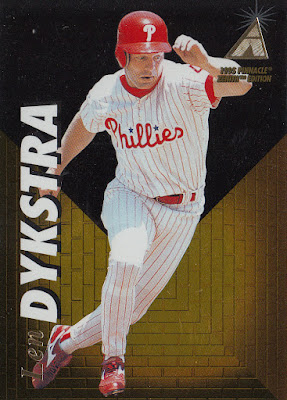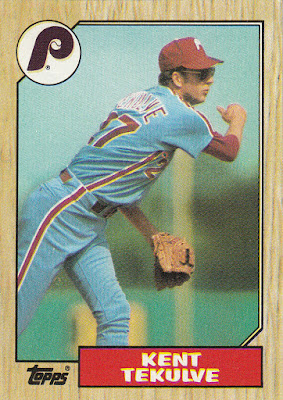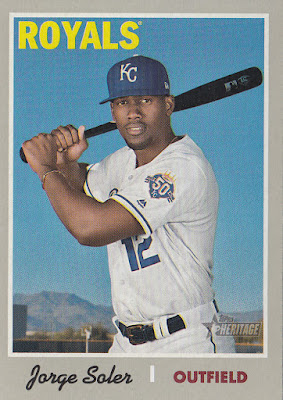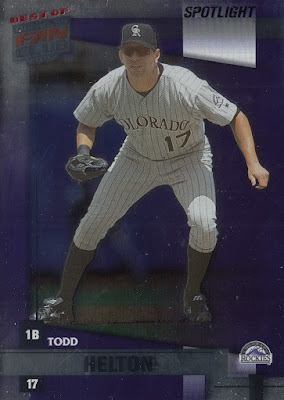Every year, a team loses the World Series. For some teams, that happens a lot, but many of them have the talent and good fortune to go on and win in other years. Others aren't quite so lucky.
In response to
Collecting Cutch's contest, in which he asks bloggers to recall a year in which their favorite team didn't win the World Series, the Cardsphere has turned out a batch of excellent posts. There are a few ways to interpret this contest, such as picking a year in which your team had no chance of going anywhere. Finishing in last place with 58 wins is technically one way to "not win the World Series". But entrants tended to pick a season in which their team came oh-so-close to winning it all. Teams like the
2003 Yankees,
1996 Braves, and
1990 Athletics simply lost the Series. The
1980 Dodgers,
2003 Red Sox,
1960 Orioles, and
2016 Red Sox fell varying lengths short of winning the pennant, or short of even making it to the postseason.
The Rockies have never won their division, but they came extremely close in 2018. For Rockies fans, a playoff appearance has always been a question of "will we win the Wild Card?" That's happened five times. And one of those years, they did the improbable and not only advanced to the NLCS, but made it all the way to the World Series.
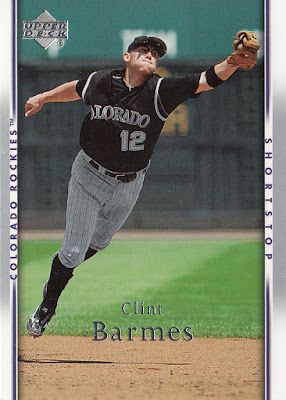 |
| 2007 Upper Deck #304 Clint Barmes |
That year was 2007, also the year of one of the least-favorite Upper Deck base sets ever. Clint Barmes was a middle infielder with a few seasons under his belt, but it all came crashing down in 2007. Despite what Upper Deck tells us, that "Barmes has consistently upped his production", his 2007 campaign was one to forget, and one that he spent most of with Triple-A Colorado Springs. He did get called back up in early August, but didn't appear on the Rockies postseason roster until their next Wild Card, in 2009.
Upper Deck did manage to give him a great action shot, which they squeezed in between the columns on both sides. His glove looks a little flat, so it's possible that this lunge didn't quite snag the ball, but we'll never know because the border cuts it off. It's appropriate for this championship that fell just out of reach.
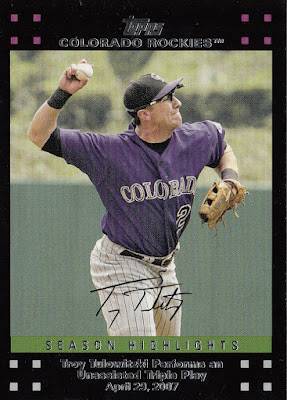 |
| 2007 Topps Update #UH209 Troy Tulowitzki SH |
A large reason why Barmes had a forgettable 2007 season was this man, Troy Tulowitzki. The talented shortstop was an enormous reason why the Rockies did as well as they did, and he almost won the NL Rookie of the Year award. He made a strong case for Barmes' starting spot, and even managed to turn an unassisted triple play in just his 46th game in the Big Leagues, as this Topps Update card documents (but does not depict). Footage of the
actual play shows Tulo wearing a different uniform than the purple jersey.
I've mentioned this before, but I was at the game the
day before that rare event happened to occur. It was against the Braves, and while I got to see future Hall-of-Famer John Smoltz pitch, it would have been amazing to see another future Hall-of-Famer, Chipper Jones, line in to such a play. It was my first of four games I attended that season, and the familiar chant of "Tu-Lo!" echoing across Coors Field graced the ballpark for many years to come, even when he visited Denver as a
Blue Jay, another game I attended.
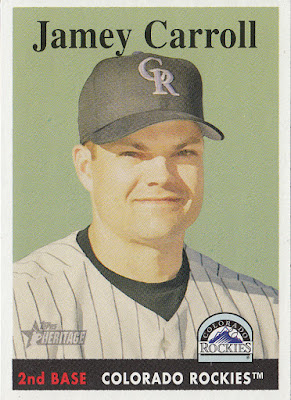 |
| 2007 Topps Heritage #247 Jamey Carroll |
Part of why the 2007 season was so amazing is that even the regular guys did pretty well. Journeyman utility player Jamey Carroll spent two years in Denver, and his trip to the postseason in 2007 was the only one of his career. Even in hitter-friendly Coors Field, he didn't put up stellar numbers, but he did hit a pinch-hit grand slam during my second trip to the ballpark that year, a work outing against the Cubs that the
Rockies won in blowout fashion. I had a new camera by then, and
snapped a shot of the center field fountains that were activated after that home run.
He also drove in the winning run in the 2007 NL Wild Card Tiebreaker game. More on that later.
The Rockies have put plenty of great fielders on the diamond, and the back of this '58-design Topps Heritage card tells us that Carroll had a stellar .995 fielding percentage in 2006, the best among NL second basemen.
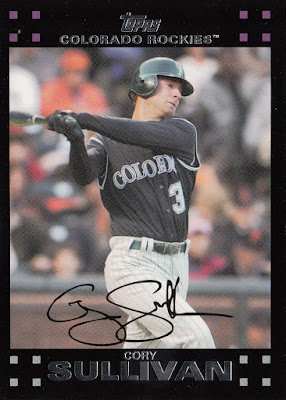 |
| 2007 Topps #205 Cory Sullivan |
Cory Sullivan was once tasked with patrolling the jumbo-sized center field bordering that fountain, and he did well, as I recall. I don't remember any home run-robbing plays like
Ian Desmond flashed the other night, but he had the speed to do it. Longtime readers might remember him as the player who hit
two triples in one inning a year prior. He's still well-known among Rockies fans, as he's an in-studio host for the Rockies' TV network.
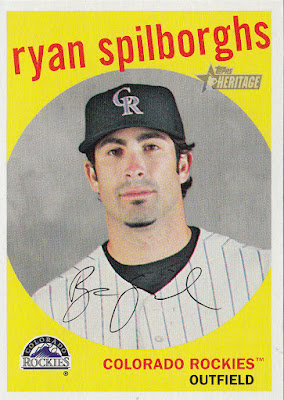 |
| 2008 Topps Heritage #394 Ryan Spilborghs |
Ryan Spilborghs shared outfield duties with Sullivan, and "Spilly" remains a fixture in the Rockies broadcast booth to this day, even though his career ended in 2011. He started in center field that day against the Cubs, and I took
this picture of him casting a shadow on the outfield grass. I was a real shutterbug back then, and that photo still graces the banner of my blog's
Facebook page. It's one of my favorite photos, and I took it from one of the top rows of the center field bleachers.
I tried really hard to only use cards from 2007 in this post, but I couldn't find a card of Spilborghs in the 2007 binder, so I had to advance one year. The 1959 design is one of my favorites, but it took a while for Topps to place him in more than a small number of sets.
I could go on with guys like this all day. Seth Smith, Jeff Baker, Kaz Matsui, Yorvit Torrealba, Willy Taveras. They weren't superstars, but they got on base, got key hits, and came through in the clutch. The Rockies are never going to be a team full of top-dollar free agents, so for them to have success, they need the right mix of average utility players that pull more than their weight and come through at the right time. When that happens, they tend to do pretty well. Exactly that happened last year in the Wild Card Game against the Cubs. In the extra-innings pitchers duel, none other than Tony Wolters got the game-winning hit. ESPN couldn't even say his name right.
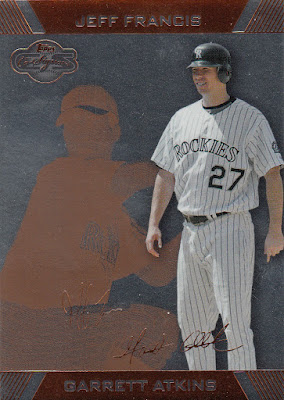 |
| 2007 Topps Co-Signers Silver Bronze #4a Garrett Atkins w/Jeff Francis /175 |
The Rockies have always been such an offense-driven club, but their pitching was quite good in 2007. The staff ace was Jeff Francis, who shares some ghostly card space with third baseman Garrett Atkins. This bronze Topps Co-Signers card was sent to me long ago by
Wes, before his recent retirement and even before a couple blog name changes.
Atkins was a middle-of-the-lineup guy, and he rewarded the Rockies with 25 home runs in '07. More importantly, Jeff Francis went 17-9 that year, putting him in a four-way tie for second place on the Rockies single-season wins leaderboard.
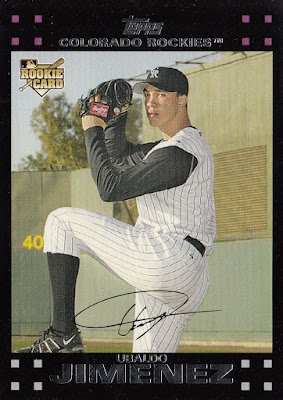 |
| 2007 Topps Update Red Back #UH43 Ubaldo Jimenez |
It wasn't until 2010, but Ubaldo Jimenez eventually eclipsed that record, winning 19 games. No Rockie has ever cracked the 20-win mark, but there are pitchers in the rotation right now who are capable of doing just that. Kyle Freeland already has one and it's just the first day of April.
Jimenez had two relief appearances in 2006, but he really got going as a member of the rotation in 2007. He and Tulowitzki gave fans a glimpse of what the Rockies would be like for several years to come. It was a young team. Of all these players so far, Clint Barmes had the most experience as a Rockie, and he was only in his fifth year.
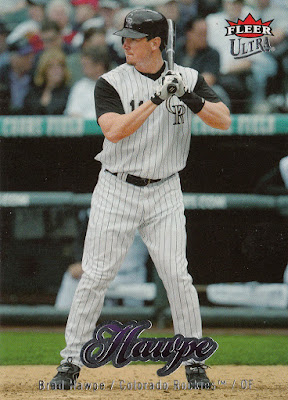 |
| 2007 Ultra #57 Brad Hawpe |
2007 Fleer Ultra, the final Ultra set to grace the hobby, had a card back very similar to 2007 Upper Deck. There is a ton of empty white space on that back, but room enough for Fleer (really UD by that time) to tell us that the right fielder was "Part of a rising young core of hitters for Colorado". Hawpe hit even more dingers in 2007 than Atkins, with 29, a career high.
I love Coors Field cards, and these lefties really get great ones. When they're at the plate, we can see right into the Rockies dugout, which is more or less an extremely close-up version of what I see when I go to the ballpark. I tend to favor the third-base side, mainly to keep the sun out of my face, but it's also nice to see my team while they're not on the field.
Speaking of right field, this is a good time to bring up the third game I attended in 2007. It was an
early-September night game against the San Francisco Giants, my first time seeing them play. If memory serves, I was was there with my dad and sister, and we sat out in right field, above the out-of-town scoreboard and underneath the overhang. That was fortunate, because if I'm thinking of the right game, it was rainy. I don't remember a delay, just a cold and wet night. Brad Hawpe was the closest player on the field to us, and while he had a hit, the Giants won that night. I even witnessed one of Barry Bonds' 762 home runs.
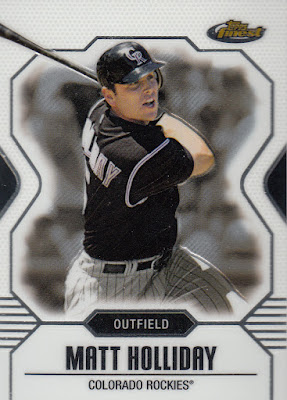 |
| 2007 Finest #53 Matt Holliday |
Other than Tulowitzki and maybe the two pitchers, casual Rockies fans probably haven't heard of most of these players, or maybe they don't have the context that current broadcasters Sullivan and Spilborghs used to play for the team. We got pretty deep into this post before I got around to the big names, and they're plenty important to the cause, but this is a team sport first and foremost. Mike Trout, who has better stats than anyone by their age-27 season, has played in a grand total of three Postseason games so far. The Angels are on the upswing, but baseball is a sport where a superstar really needs his teammates to shine.
Topps Finest has always been a pretty small set, so only the big names like Matt Holliday get included. The power hitter led the 2007 team with 36 home runs and 120 runs scored, the last one being pivotal to win game 163 and eclipse the Padres to win the Wild Card. It's easily the most
controversial play in Rockies history and, to be honest, probably wouldn't pass replay review in this day and age. It's important to note, though, that Garrett Atkins hit a home run in the 7th inning that evening that was incorrectly ruled a double. If replay review existed, the game would have been over in regulation. But no one really talks about that.
Either way, the call in the 13th inning went the Rockies' way, and he remained such a fan favorite that the Rockies brought him back for the last couple months of 2018. He even appeared on last year's postseason roster, going 2-for-8 and bringing a ton of postseason experience to the clubhouse.
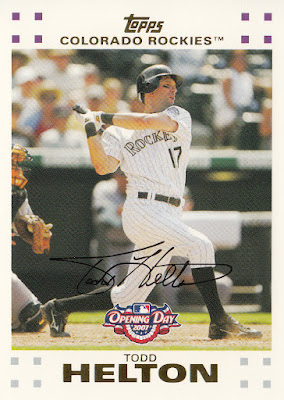 |
| 2007 Topps Opening Day #81 Todd Helton |
And here's that last big name you've been expecting all along, Todd Helton. I've used a lot of 2007 Topps in this post, so here's a look at the white-and-gold interpretation of the filmstrip design, courtesy of Topps Opening Day. Helton, whose number 17 has since been retired by the club, is the most well-known player on this whole team. He had been in the Majors for quite some time before he got a taste of the Postseason, and was an integral part of the Rockies sweeping both the NLDS and NLCS before encountering the buzzsaw that was the Boston Red Sox.
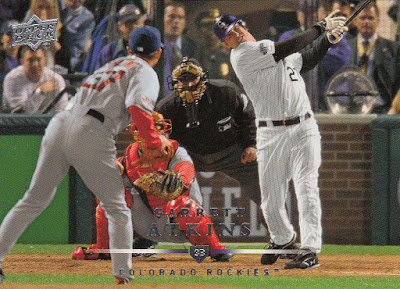 |
| 2008 Upper Deck #484 Garrett Atkins |
That brings us to the final game I saw in 2007,
Game 3 of the World Series. My boss got tickets from a business contact, and decided to take me, the resident baseball fan, to the game. This card is one of the great Coors Field cards, and I dipped into the 2008 binder a second time to find it. That's Hideki Okajima on the hill for Boston, and he faced Garrett Atkins twice, once each in Games 3 and 4. Atkins struck out in Game 3, but took Okajima deep in Game 4, bringing the Rockies to within 1 run of Boston. It would be the last run they'd score that series.
This card might depict that home run, which I think would be preferable for a card of a Rockie, but it might depict that strikeout in Game 3, which would be pretty awesome for this baseball fan. Other than Topps Now, I've only found
one card from a game I attended. 50/50 that this is another one, and what a game it was.
Even though they lost, it is a magical experience to watch your team play in a World Series. Yes, I had my
camera. And I'll never forget it.
Still, it would be great to win one of these.




